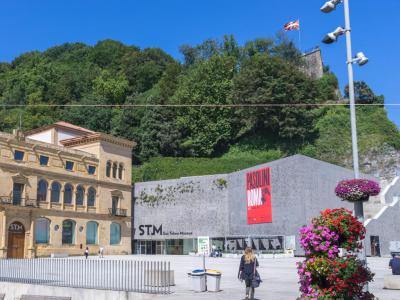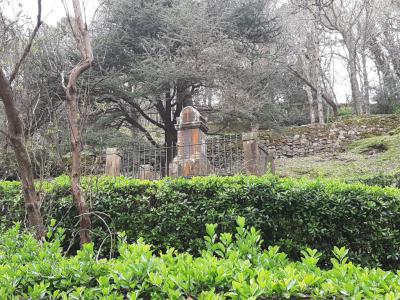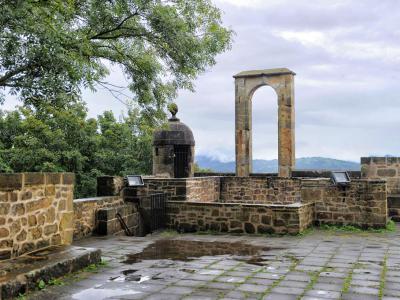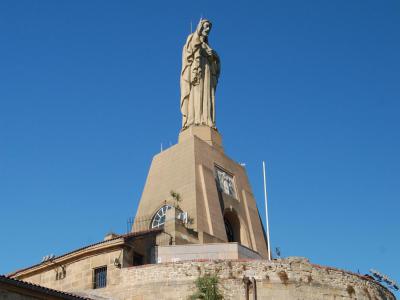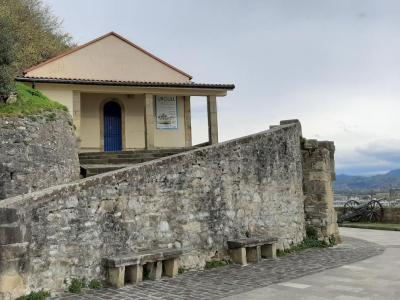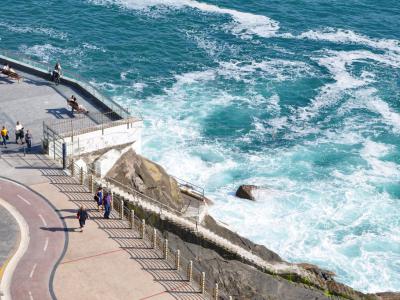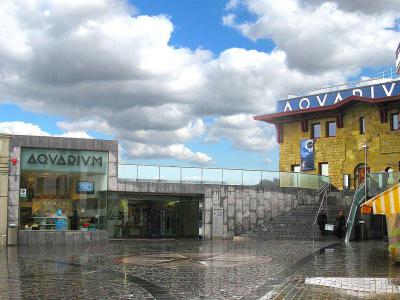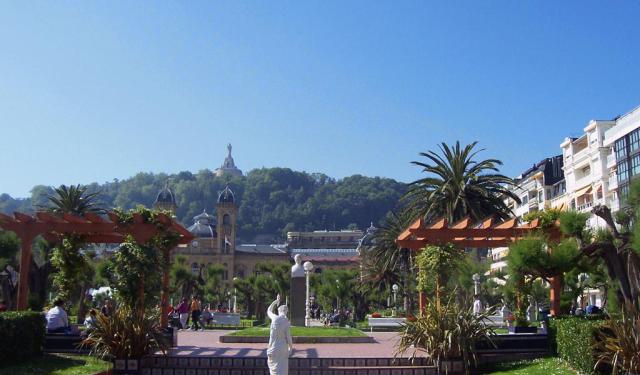Mount Urgull Walking Tour (Self Guided), San Sebastian
Mount Urgull is a promontory stretching out at the eastern end of La Concha Bay, surrounded by water on all sides, except the one linking it to the Old Town of San Sebastian. Historically, this mount, rising 123 meters above sea level, served as a strategic defense point for the city, attesting to which now are the remnants of old fortifications with cannons still in place.
From its elevated position, Mount Urgull affords a magnificent panorama of the city – stretching from the Gros district and Playa de Zurriola to the bay and the port – which, together with lush vegetation, including oak and pine trees, and several walking trails winding their way up to the top, makes the hill a popular tourist destination and a great spot for outdoor activities such as hiking and picnicking.
Beginning at the Aquarium, home to a wide range of marine life, the Paseo Nuevo (New Promenade) encircles the entire hill, which is crowned by the Castillo de la Mota (Mota Castle), a formidable 12th-century fortress hosting the History House Museum, granting insight into San Sebastian’s past.
Another local attraction is the Sagrado Corazon (Sacred Heart) Monument, a large statue of Jesus Christ that stands atop Mount Urgull. Visitors are free to climb the stairs to the base of the statue for a closer look and stunning views of the surrounding area.
Other points of interest on the Mount include a cemetery for British soldiers who died during the Peninsular War, the Museo San Telmo (San Telmo Museum) housed in a former 16th-century convent and boasting a wide range of exhibits on Basque history and culture, and La Batería de la Damas (The Ladies Battery), a historic fort with a network of tunnels open to the public.
For a more detailed acquaintance with this scenic seaside location, offering a unique combination of natural beauty, historical significance, and cultural attractions, embark on a self-guided walking tour with the help of the GPSmyCity app and make the most of your trip to San Sebastian.
From its elevated position, Mount Urgull affords a magnificent panorama of the city – stretching from the Gros district and Playa de Zurriola to the bay and the port – which, together with lush vegetation, including oak and pine trees, and several walking trails winding their way up to the top, makes the hill a popular tourist destination and a great spot for outdoor activities such as hiking and picnicking.
Beginning at the Aquarium, home to a wide range of marine life, the Paseo Nuevo (New Promenade) encircles the entire hill, which is crowned by the Castillo de la Mota (Mota Castle), a formidable 12th-century fortress hosting the History House Museum, granting insight into San Sebastian’s past.
Another local attraction is the Sagrado Corazon (Sacred Heart) Monument, a large statue of Jesus Christ that stands atop Mount Urgull. Visitors are free to climb the stairs to the base of the statue for a closer look and stunning views of the surrounding area.
Other points of interest on the Mount include a cemetery for British soldiers who died during the Peninsular War, the Museo San Telmo (San Telmo Museum) housed in a former 16th-century convent and boasting a wide range of exhibits on Basque history and culture, and La Batería de la Damas (The Ladies Battery), a historic fort with a network of tunnels open to the public.
For a more detailed acquaintance with this scenic seaside location, offering a unique combination of natural beauty, historical significance, and cultural attractions, embark on a self-guided walking tour with the help of the GPSmyCity app and make the most of your trip to San Sebastian.
How it works: Download the app "GPSmyCity: Walks in 1K+ Cities" from Apple App Store or Google Play Store to your mobile phone or tablet. The app turns your mobile device into a personal tour guide and its built-in GPS navigation functions guide you from one tour stop to next. The app works offline, so no data plan is needed when traveling abroad.
Mount Urgull Walking Tour Map
Guide Name: Mount Urgull Walking Tour
Guide Location: Spain » San Sebastian (See other walking tours in San Sebastian)
Guide Type: Self-guided Walking Tour (Sightseeing)
# of Attractions: 7
Tour Duration: 1 Hour(s)
Travel Distance: 2.7 Km or 1.7 Miles
Author: DanaOffice
Sight(s) Featured in This Guide:
Guide Location: Spain » San Sebastian (See other walking tours in San Sebastian)
Guide Type: Self-guided Walking Tour (Sightseeing)
# of Attractions: 7
Tour Duration: 1 Hour(s)
Travel Distance: 2.7 Km or 1.7 Miles
Author: DanaOffice
Sight(s) Featured in This Guide:
- Museo San Telmo (San Telmo Museum)
- The English Cemetery
- La Mota Castle
- Monumento al Sagrado Corazon (Monument of the Sacred Heart)
- La Batería de la Damas (The Ladies Battery”)
- Paseo Nuevo (New Promenade)
- San Sebastian Aquarium
1) Museo San Telmo (San Telmo Museum) (must see)
The San Telmo Museum doesn’t so much stand at the foot of Mount Urgull as it stages a centuries-long performance, with each act changing the set. It began in 1562, when a Dominican convent was built here and dedicated to Saint Elmo, patron saint of sailors. Back then San Sebastián was a fortified port town, and the friars were spiritual lifeguards for a community living by the tides. The Gothic church and Renaissance cloister they left behind still frame the story, solid and austere yet edged with a touch of elegance.
Time, of course, had its way with the convent. The 19th century expelled the friars and conscripted the building as a military barracks-proof that even sacred walls can end up drafted. By 1929, the city reclaimed the site, and a few years later it reemerged as the San Telmo Museum, encouraged by the Royal Basque Society of Friends of the Country. Founded in 1765, that society aimed to foster culture and industry, and here they secured a stage for Basque history itself.
The plot thickened in 2011, when the convent got a sleek new co-star: glass-and-steel pavilions clad in aluminum panels punctured with plant life. Suddenly, the oldest museum in the Basque Country looked very much alive in the 21st century.
Step inside, and the exhibits unfold like scenes in a kaleidoscope: prehistoric tools beside Basque folk costumes, Renaissance canvases by El Greco and Sorolla, football jerseys, bicycles, and modernist experiments by Oteiza, Chillida, and Zumeta. The former church, meanwhile, wears its history in grand murals by José María Sert, transforming devotion into drama.
San Telmo is less a museum than a mirror: it reflects the contradictions and continuities of Basque identity. Wander its cloisters or its aluminum-paneled halls, and you’ll sense how this city has always balanced the pull of tradition with the lure of reinvention.
Time, of course, had its way with the convent. The 19th century expelled the friars and conscripted the building as a military barracks-proof that even sacred walls can end up drafted. By 1929, the city reclaimed the site, and a few years later it reemerged as the San Telmo Museum, encouraged by the Royal Basque Society of Friends of the Country. Founded in 1765, that society aimed to foster culture and industry, and here they secured a stage for Basque history itself.
The plot thickened in 2011, when the convent got a sleek new co-star: glass-and-steel pavilions clad in aluminum panels punctured with plant life. Suddenly, the oldest museum in the Basque Country looked very much alive in the 21st century.
Step inside, and the exhibits unfold like scenes in a kaleidoscope: prehistoric tools beside Basque folk costumes, Renaissance canvases by El Greco and Sorolla, football jerseys, bicycles, and modernist experiments by Oteiza, Chillida, and Zumeta. The former church, meanwhile, wears its history in grand murals by José María Sert, transforming devotion into drama.
San Telmo is less a museum than a mirror: it reflects the contradictions and continuities of Basque identity. Wander its cloisters or its aluminum-paneled halls, and you’ll sense how this city has always balanced the pull of tradition with the lure of reinvention.
2) The English Cemetery
The English Cemetery is a hidden gem that is not to be missed. Tucked away on one of the slopes of the iconic Mount Urgull, it is a mystical and tranquil place that exudes an aura of peace and serenity.
As you make your way towards the cemetery along el Paseo Nuevo, you will notice the verdant and shadowy atmosphere that surrounds you. The path winds between visible headstones and explanatory plaques, making it a wonderful way to enjoy the calming effect of nature.
Founded in 1924, the cemetery has been standing for almost a century. The moss that covers nearly the entire edifice creates an attractive effect that is both mesmerizing and unique. It is a required stop if you are going anywhere near Mount Urgull.
One of the most popular locations in the cemetery is the lookout, which provides a stunning view of the city and the Bay of Biscay. It will leave you with a lasting impression of this iconic mountain.
As you make your way towards the cemetery along el Paseo Nuevo, you will notice the verdant and shadowy atmosphere that surrounds you. The path winds between visible headstones and explanatory plaques, making it a wonderful way to enjoy the calming effect of nature.
Founded in 1924, the cemetery has been standing for almost a century. The moss that covers nearly the entire edifice creates an attractive effect that is both mesmerizing and unique. It is a required stop if you are going anywhere near Mount Urgull.
One of the most popular locations in the cemetery is the lookout, which provides a stunning view of the city and the Bay of Biscay. It will leave you with a lasting impression of this iconic mountain.
3) La Mota Castle
La Mota Castle is a 12th-century military fortress situated at the summit of Mount Urguell in San Sebastian,. Built in 1194 by King Sancho VII of Navarre to protect the city from foreign attacks, the fortress has survived the test of time and remains intact to this day. Throughout history, the castle has been under the control of many monarchs, each of whom contributed to its evolution.
During the Franco-Portuguese siege in 1476, the fortress played a key role in providing shelter to the city's inhabitants. In the 16th century, Carlos V ordered several additional reforms, including the construction of a keep, a fortified barbican, and gallows, as well as the cutting down of all trees to thwart attacks from foreign troops.
The fortress was struck by lightning twice, once in 1575 and again in the 17th century. Despite these setbacks, it remained impregnable, enduring attacks and sieges during the Spanish War of Independence and the Carlist Wars.
In the 20th century, the fortress was abandoned and fell into disrepair until it was restored and declared a National Monument of Historical-Artistic Heritage in 1921. During the 1960s, it underwent a significant overhaul and was reopened as a cultural space.
Today, Castillo de la Mota stands as a testament to San Sebastian's rich history and the strength and endurance of its people. The fortress is a popular tourist destination and a must-see for anyone interested in Spanish history and architecture.
During the Franco-Portuguese siege in 1476, the fortress played a key role in providing shelter to the city's inhabitants. In the 16th century, Carlos V ordered several additional reforms, including the construction of a keep, a fortified barbican, and gallows, as well as the cutting down of all trees to thwart attacks from foreign troops.
The fortress was struck by lightning twice, once in 1575 and again in the 17th century. Despite these setbacks, it remained impregnable, enduring attacks and sieges during the Spanish War of Independence and the Carlist Wars.
In the 20th century, the fortress was abandoned and fell into disrepair until it was restored and declared a National Monument of Historical-Artistic Heritage in 1921. During the 1960s, it underwent a significant overhaul and was reopened as a cultural space.
Today, Castillo de la Mota stands as a testament to San Sebastian's rich history and the strength and endurance of its people. The fortress is a popular tourist destination and a must-see for anyone interested in Spanish history and architecture.
4) Monumento al Sagrado Corazon (Monument of the Sacred Heart)
The Monument of the Sacred Heart is a spectacular monument located at the highest point of Mount Urgull in San Sebastian. From this vantage point, visitors are treated to breathtaking views of San Sebastian's two famous beaches, Ondarreta and Concha, as well as the surrounding mountains. The monument was erected over a period of several years, with the Board of the Sacred Heart of Jesus Monument constituting in 1939 and the monument being completed in November 1950.
The monument was designed by architect Pedro Muguruza Otaño, in collaboration with sculptor Federico Coullant. The monument stands on a 10 x 8 meter base with a staircase, and a trapezoidal shape 13.6 meters high emerges from it. This trapezoidal shape houses the chapel and represents the elevation of the image. Above it, a 2.5-meter octagonal pedestal serves as a transition to the cylindrical shape of the image. The 12.5 meter image of the Sacred Heart stands atop the pedestal, facing the city with the right hand in an attitude of blessing and the left pointing to the Heart. On the front of the trapezoidal shape, there is a plate with a relief of the Heart of Mary.
The body of the monument is made of concrete, covered with stone veneer in the base and trapezoidal area. The image of the Sacred Heart was made with special concrete with marble and white cement aggregates in the noble areas, and covered with slightly yellow-colored sandstone for the rest of the figure.
The monument was inaugurated on November 19, with the blessing of the statue and a mass officiated by the bishop. Later, a chapel was built adjacent to the monument, which serves as a shelter for the faithful. The chapel was inaugurated on December 26, 1955.
The monument stunning location, intricate design, and historical significance make it a unique and memorable attraction.
The monument was designed by architect Pedro Muguruza Otaño, in collaboration with sculptor Federico Coullant. The monument stands on a 10 x 8 meter base with a staircase, and a trapezoidal shape 13.6 meters high emerges from it. This trapezoidal shape houses the chapel and represents the elevation of the image. Above it, a 2.5-meter octagonal pedestal serves as a transition to the cylindrical shape of the image. The 12.5 meter image of the Sacred Heart stands atop the pedestal, facing the city with the right hand in an attitude of blessing and the left pointing to the Heart. On the front of the trapezoidal shape, there is a plate with a relief of the Heart of Mary.
The body of the monument is made of concrete, covered with stone veneer in the base and trapezoidal area. The image of the Sacred Heart was made with special concrete with marble and white cement aggregates in the noble areas, and covered with slightly yellow-colored sandstone for the rest of the figure.
The monument was inaugurated on November 19, with the blessing of the statue and a mass officiated by the bishop. Later, a chapel was built adjacent to the monument, which serves as a shelter for the faithful. The chapel was inaugurated on December 26, 1955.
The monument stunning location, intricate design, and historical significance make it a unique and memorable attraction.
5) La Batería de la Damas (The Ladies Battery”)
The Ladies Battery is a historically-rich military area located at the foot of Monte Urgull in San Sebastian. It was constructed to defend the port and could beat the entrance to the bay, the island of Santa Clara, and Mount Igueldo. The battery occupies the spot where the Santa Clara Sentry Box once stood. The name "Batería de las Damas" comes from the fountain that used to be located in the lower part of the bastion. Local women would come here to collect water, and the only path that led to the fountain crossed the battery. This resulted in frequent encounters between soldiers and the women from the city.
Today, visitors to the Batería de las Damas can explore the cannons that were used during wars in Morocco, and a house that once served as a museum of military miniatures. The upper part of the Battery is home to a library that is open during Easter Week and the summer months. On days when the sea is rough, visitors can go to the lookout points and witness the waves leaping over the breaker wall, creating a breathtaking image of the city.
The Batería de las Damas can be freely visited, and it is one of the most historically significant corners of Monte Urgull. With its strategic location and impressive cannons, it is an important reminder of the city's military past.
Today, visitors to the Batería de las Damas can explore the cannons that were used during wars in Morocco, and a house that once served as a museum of military miniatures. The upper part of the Battery is home to a library that is open during Easter Week and the summer months. On days when the sea is rough, visitors can go to the lookout points and witness the waves leaping over the breaker wall, creating a breathtaking image of the city.
The Batería de las Damas can be freely visited, and it is one of the most historically significant corners of Monte Urgull. With its strategic location and impressive cannons, it is an important reminder of the city's military past.
6) Paseo Nuevo (New Promenade)
Paseo Nuevo is a charming promenade that encircles the Urgull mount. Starting from the Aquarium and ending at the Old Town, beside the Kursaal, this picturesque avenue offers stunning views of the La Concha bay and the Cantabrian Sea throughout the entire walk. It is a peaceful and serene area, perfect for a leisurely stroll.
The entire distance of the promenade can be covered on foot in about 40 minutes, making it an easily accessible attraction for tourists. While vehicles are permitted on the promenade, it is a quiet zone with few cars passing through, making it safe for children to walk around. Visitors looking for parking in the city centre can find parking facilities in this area.
One of the main draws of Paseo Nuevo is the spectacular sight of the rough seas crashing against the promenade during high tide. This has made the promenade famous, with countless photographs and television broadcasts showcasing the dramatic waves. However, caution must be exercised as this can be a dangerous phenomenon if safety measures are not followed.
All in all, Paseo Nuevo is a must-visit destination for anyone looking for a scenic and peaceful stroll in San Sebastian.
The entire distance of the promenade can be covered on foot in about 40 minutes, making it an easily accessible attraction for tourists. While vehicles are permitted on the promenade, it is a quiet zone with few cars passing through, making it safe for children to walk around. Visitors looking for parking in the city centre can find parking facilities in this area.
One of the main draws of Paseo Nuevo is the spectacular sight of the rough seas crashing against the promenade during high tide. This has made the promenade famous, with countless photographs and television broadcasts showcasing the dramatic waves. However, caution must be exercised as this can be a dangerous phenomenon if safety measures are not followed.
All in all, Paseo Nuevo is a must-visit destination for anyone looking for a scenic and peaceful stroll in San Sebastian.
7) San Sebastian Aquarium
The San Sebastian Aquarium is a must-visit attraction for anyone interested in marine life and maritime history. Not only does it house a stunning oceanarium with a 360-degree view of sharks, jellyfish, seahorses, and other fish species, but it also has a tactile aquarium that allows visitors to touch the marine creatures.
In addition to the aquariums, the San Sebastian Aquarium also features an oceanographic museum with exhibits that showcase the Basque Country and San Sebastian's rich maritime and marine history. You can learn about the region's fishing and corsair traditions, the boats used by local sailors, and the creation of the Oceanographic Society of Gipuzkoa, which has been dedicated to the study and dissemination of oceanographic content for over a century.
The San Sebastian Aquarium is more than just a tourist attraction; it's also a scientific research center. The Gipuzkoa Oceanographic Society, which founded the aquarium in 1908, has carried out scientific research work in the Basque marine environment and around the world.
Whether you're interested in learning about the marine life in the Bay of Biscay or the maritime history of San Sebastian, the San Sebastian Aquarium is an excellent destination. With its combination of scientific exhibits and stunning aquariums, it's an educational and enjoyable experience for visitors of all ages.
In addition to the aquariums, the San Sebastian Aquarium also features an oceanographic museum with exhibits that showcase the Basque Country and San Sebastian's rich maritime and marine history. You can learn about the region's fishing and corsair traditions, the boats used by local sailors, and the creation of the Oceanographic Society of Gipuzkoa, which has been dedicated to the study and dissemination of oceanographic content for over a century.
The San Sebastian Aquarium is more than just a tourist attraction; it's also a scientific research center. The Gipuzkoa Oceanographic Society, which founded the aquarium in 1908, has carried out scientific research work in the Basque marine environment and around the world.
Whether you're interested in learning about the marine life in the Bay of Biscay or the maritime history of San Sebastian, the San Sebastian Aquarium is an excellent destination. With its combination of scientific exhibits and stunning aquariums, it's an educational and enjoyable experience for visitors of all ages.
Walking Tours in San Sebastian, Spain
Create Your Own Walk in San Sebastian
Creating your own self-guided walk in San Sebastian is easy and fun. Choose the city attractions that you want to see and a walk route map will be created just for you. You can even set your hotel as the start point of the walk.
San Sebastian Introduction Walking Tour
After watching bulls run around in Pamplona, Ernest Hemingway took a relaxing trip up north. He enjoyed the calmness of the shoreline so much that he vividly described it in his novel The Sun Also Rises. The city that appealed to Hemingway was San Sebastián-known in Basque as Donostia.
The city takes its name from Saint Sebastian, the early Christian martyr whose cult spread widely through... view more
Tour Duration: 2 Hour(s)
Travel Distance: 3.0 Km or 1.9 Miles
The city takes its name from Saint Sebastian, the early Christian martyr whose cult spread widely through... view more
Tour Duration: 2 Hour(s)
Travel Distance: 3.0 Km or 1.9 Miles
The Most Popular Cities
/ view all



